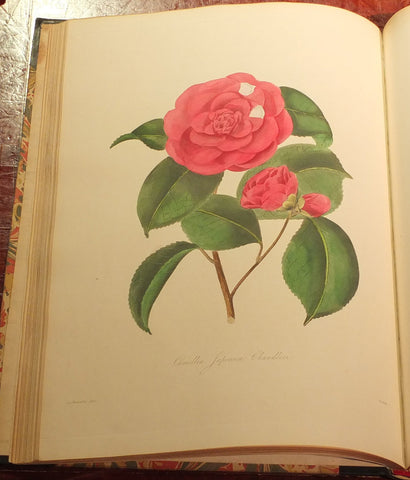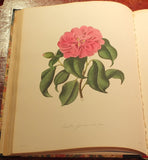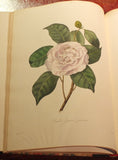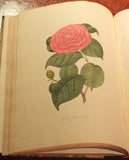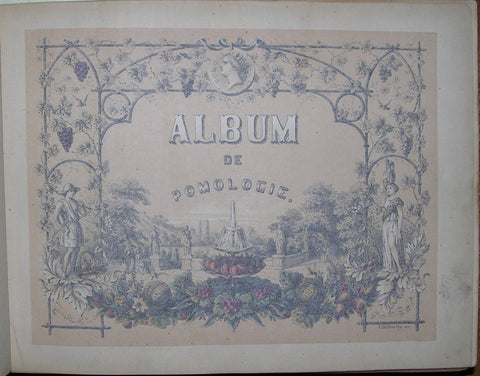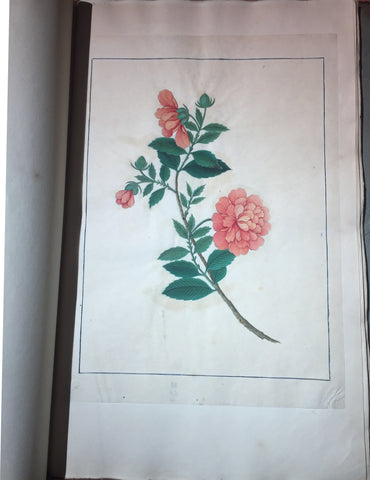Alfred Chandler (1804-1896) William Beattie Booth (?1804-1874), Illustrations And Descriptions Of The Plants Which Compose The Natural Order Camellieae
Alfred Chandler (1804-1896) William Beattie Booth (?1804-1874)
Illustrations And Descriptions Of The Plants Which Compose The Natural Order Camellieae
London: John and Arthur Arch, 1831.
Folio, (14 5/8 x 10 ¾ inches). 40 fine engraved plates with original hand color (one or two marginal spots, occasional offsetting). Modern half black calf, marbled boards, the spine in six compartments separated by five raised bands, red morocco gilt lettering piece in one (over-opened at plate 18, rubbed).
Provenance: With ink library stamps of “King’s Inns Library Dublin” to verso of title page and last page of text. Swann, Mar 22, 1990, lot 41.
“BEAUTIFULLY COLORED WITH OPAQUE PIGMENTS” (Dunthorne)
First edition, DELUXE ISSUE. Volume one, all published. 40 “HANDSOME AND RARE” (Blunt) hand-colored engravings after Alfred Chandler’s original drawings based on specimens from his father’s nursery at Vauxhall. Each engraving is accompanied by descriptive text, including physical description, cultivation, and when the plant first appeared in England. Included are “five species of Camellia, sixteen varieties of Camellia Japonica, which have been imported from China, and nineteen selected from those which have been raised from seed in this country” ( Preface). This book “exists in three states, i.e. with uncoloured plates, coloured plates, and more highly finished coloured plates on large paper” (Sitwell), of which this is the large-paper deluxe edition.
William Beattie Booth was recognized as a leading expert on Camellias, presenting a paper on the subject in two sessions of the Horticultural Society in London in 1829. Although membership in the Society largely consisted of the landed gentry, well-regarded gardeners on the estate were often granted the status of corresponding members. Booth is listed in the published papers as “Garden Clerk.”
The flowers pictured include: Single Red Camellia, Apple-blossomed Camellia, Oil-seed Camellia, Captain Rawes’s Camellia, Lady Banks’s Camellia, Palmer’s Semi-double White Camellia, Double White Camellia, Anemone-flowered, or Waratah Camellia, Loddige’s Red Camellia, Middlemist’s Red Camellia, Mr. Kent’s Camellia, Fringed Double White Camellia, Crimson Shell-flowered Camellia, Lady Hume’s Blush Camellia, Myrtle-leaved Camellia, Red Paeony-flowered Camellia, Pompone Camellia, Double Red Camellia, Captain Rawes’s variegated Waratah Camellia, Double-striped Camellia, Captain Welbank’s Camellia, Single White Camellia, Mr. Aiton’s Camellia, Hollyhock-flowered Camellia, White Anemone-flowered Camellia, Mr. Chandler’s Camellia, Mr. Chandler’s neat Camellia, Coral-coloured Camellia, Press’s Eclipse Camellia, Mr. Chandler’s Elegant Camellia, Mr. Young’s Semi-double Red Camellia, Mr. Chandler’s choice-flowered Camellia, Cluster-flowering Camellia, Splendid Camellia, Gray’s Invincible Camellia, China Rose Camellia, Mr. Ross’s Camellia, Mr. Allnut’s Cammellia, Lady Wilton’s Camellia, Mr. Wood’s Camellia. Nissen BBI 209. Dunthorne 77. Great Flower Books, p. 80. Stafleu & Cowen TL2 651. BMNH I, 199.
We Also Recommend

